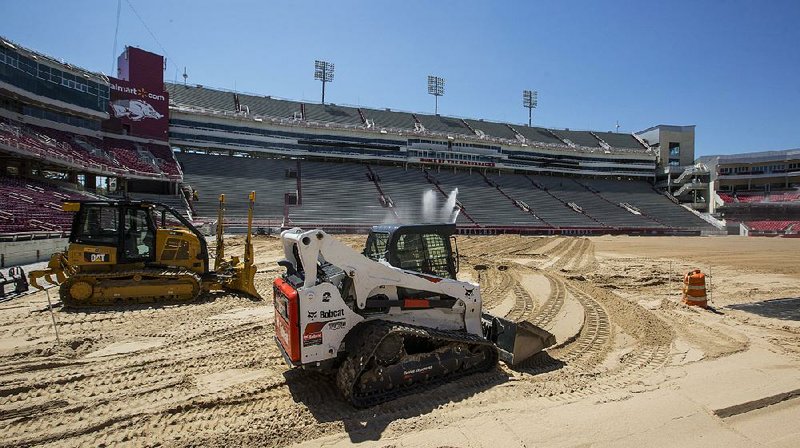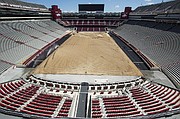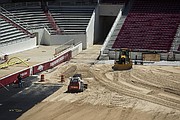FAYETTEVILLE -- Natural grass will return to the field at Reynolds Razorback Stadium within a few weeks.
The University of Arkansas football team will play home games on a natural surface this fall for the first time since 2008 -- the team's first season under then-head coach Bobby Petrino, who had artificial turf installed in 2009 at a cost of $1.1 million.
Petrino said the synthetic surface was needed to withstand the wear and tear of his practices. Petrino preferred to have most of his practices inside the stadium, and the grass field showed some signs of overuse by the end of 2008.
Ten years after Petrino lobbied for a new field in his first season, another new Arkansas head coach, Chad Morris, said he preferred natural grass, citing his experience coaching Texas high school teams.
[Video not loading? Click here to watch » https://www.youtube.com/watch?v=b8TNIe3n-R0]
The change could not be made in time for Morris' inaugural season because construction to the stadium's north side wasn't completed until August. With a crane sitting inside the stadium, the turf was peeled back roughly 40 yards most of last year, then laid back down shortly before the 2018 season opener against Eastern Illinois.
Arkansas began tearing out the turf field in April and expects to have real grass in the stadium by early August. The estimated cost to switch the field back to grass is $963,000.
Perception of turf and natural grass appears to have changed in the decade between Petrino and Morris. Some research has suggested that turf -- which is less forgiving than grass on impact -- presents a greater risk for concussions, and some rubber pellets used in turf fields to provide traction have been found to contain harmful chemicals.
Neither has been known to be an issue in Fayetteville, where the most commonly heard complaint about the turf field related to how it looked on high-definition TVs at night, when the lights caused a shiny glare on the field and exposed a contrast between the lighter red color on the field and the darker color of Arkansas' uniforms. The Razorbacks altered their shade of red from 200 to the slightly darker 201 on the Pantone Matching System in 2014, five years after the turf field was installed.
Morris even hinted that his preference is based on appearance.
"There's nothing better to go out on a great grass field on a Saturday afternoon or a Saturday evening that's manicured, that's painted up," Morris said Wednesday. "You've got the smell of the grass. It's just what college football is about."
Nationwide, the change from turf to grass appears to have been countered by a comparable number of changes in the opposite direction. In the SEC, Ole Miss changed back to grass in 2016 after installing turf the same year as Arkansas, but one year earlier Kentucky ripped up its native bluegrass and replaced it with synthetic turf.
Many SEC teams went back to grass after the AstroTurf phase of the 1970s and '80s. When the Razorback Stadium surface is replaced, 11 of 14 SEC teams will have natural grass home fields. War Memorial Stadium in Little Rock, where the Razorbacks will play every other year, has a turf field that was replaced in February.
The other turf fields in the SEC are at Vanderbilt and Missouri, which like Arkansas and Kentucky are among the conference's northernmost locations where grass struggles to grow late in the fall.
There have been significant advances in grass research in the past decade, though, and Arkansas will be the first college or professional team to install Tahoma 31, a variety of Bermuda grass. Tahoma 31 was designed to be tolerant to drought and cold and resilient in shade. Research suggests it will withstand the foot traffic of a football season well.
"They are rebuilding the natural grass field similarly to how golf course putting greens are constructed," said Doug Karcher, a horticulture professor who teaches turf management at the University of Arkansas' Dale Bumpers College of Agriculture, Food and Life Sciences. "This is technology that the United States Golf Association uses -- a very sophisticated system that will allow for really good resistance to compaction, good aeration, good rooting, great drainage, but also have a root zone that will retain some moisture at the same time."
Fielding options
It wasn't long after he was hired as the Arkansas football coach in December 2017 that Morris was asked about his preference between grass and artificial turf.
"Maybe that's just the high school coach in me ... but I prefer, I'm a natural grass type of guy," Morris said on March 3, 2018. "I love being on a grass field. There's nothing better than that in college football, or football period."
Replacing the turf at Reynolds Razorback Stadium had been on the radar for administrators because the turf field installed in 2009 was nearing the end of its life. Turf fields are typically replaced about every 10 years.
Arkansas had considered replacing the turf last year as part of the construction that added new club seats and suites to the north end of the stadium, but held off because it would add another wrinkle to an already complex project.
"We knew we could get through construction better with an artificial turf than we could grass, just because of all the construction traffic going back and forth," said Justin Maland, assistant athletic director for facilities at Arkansas. "We made plans for pulling that turf back, protecting it and then we used that as a construction zone."
But even while the north end zone construction was taking place, Karcher and his colleagues were discussing the possibility of a new field. Karcher suggested Tahoma 31, which he had been researching since 2013 when the Bermuda variety was still referred to as OKC 1131, the trial name given by developers of the variety at Oklahoma State University.
Tahoma 31 was engineered to grow well in Midwest climates such as the one in Fayetteville. Karcher said the grass has held up well during cold Arkansas winters since he began testing it six years ago, including the particularly frigid and precipitous winter of 2013-14.
"There are two things that can kill Bermuda grass, because it's hard to kill. One is shade and the other is cold," Karcher said. "Oklahoma State has done a really good job working out cold tolerance in Bermuda grasses that make that less of an issue around here."
According to Tahoma 31's website, it had a winterkill rate of 25% in Lexington, Ky., in 2014, compared to winterkill rates between 50% and 99% for the five other variations of Bermuda grass tested at the same location at the same time.
Cold and shade have caused issues at Reynolds Razorback Stadium in the past. When the south end zone seating structure was constructed prior to the 2001 season, the sod at the time -- Tifway 419 -- did not handle the added shade well during colder months. Another Bermuda variety, Riviera, was added a couple of years before the switch to turf and was better equipped to handle the shade.
Tahoma 31 was "a top performer" in testing, Karcher said.
"We have all kinds of research data showing how well it has adapted to Fayetteville," Karcher said. "We didn't put a whole lot of football-simulated traffic on it, but we have counterparts at the University of Tennessee in Knoxville that do a lot of traffic research and they've had it in their trials, and it has performed really well; at the top in their trials. With all that data, we're convinced ... that it's going to do very well."
In addition to climate, a key consideration at Reynolds Razorback Stadium is its natural sand-based root zone. Karcher said it was important to grow the sod to be installed on top of sand that is similar to the sand at the stadium.
A farm near Tulsa was considered, but it was not selected because the sod there is grown on top of soil, and "soil and sand do not mix well," Karcher said, adding it can cause grass to rip apart in large clusters that cause traction issues.
The grass is being grown at Winstead Turf Farms in Arlington, Tenn., just outside of Memphis.
"They were chosen because they were the closest sod farm that could produce Tahoma 31 grown on sand," Karcher said. "These guys are big-time sod growers and have a very professional operation -- take on a lot of high-profile jobs. I was excited to hear they were one of the few sod farms licensed to grow Tahoma 31."
The Winstead farm isn't naturally sandy, but the owners grow sod on top of plastic, which allows for a sand base that is uncontaminated by the underlying soil. The sand used at the farm is similar to the texture as the sand beneath Reynolds Razorback Stadium that Karcher compared to masonry sand used by bricklayers.
"They have to do a really good job of monitoring their watering because that can dry out super quick with the sand on top of plastic," Karcher said.
Winstead also uses a technology called Matrix to strengthen the base of the sod. Developed in Australia and used there on rugby fields, Matrix is described by Karcher as "loosely woven plastic material" that is mixed into the sand above the plastic base.
"The Bermuda grass roots down into the sand and into the Matrix with the idea being that's going to give it superior sod strength, and be much less likely to divot," Karcher said.
After the sod is installed in Fayetteville, the Winstead farm essentially will have sod set aside for the Razorbacks if more is needed.
"If we have a really bad scenario of a game and the field got torn up, we'll have another field in Memphis essentially sitting there waiting for our needs," Maland said. "We'll have a safety net of sorts."
Gathering sand
Crews have spent the past two weeks laying down an additional 12 inches of sand atop a 4-inch gravel base inside the stadium. A similar amount of sand was removed 10 years ago to give the turf field a proper grade, Karcher said.
The sand is being imported from the Arkansas River at Van Buren because of similarities with the sand at the stadium. Those working on the project were nervous about meeting deadlines when heavy rains caused record flooding along the river in early June. In Van Buren, the river crested at 40.8 feet, nearly two times above the flood level of 22 feet.
"We weren't sure how long it was going to take for the sand pits to become operational again," Karcher said, "but fortunately it wasn't too long after the water started receding that they were able to produce mason sand out of the river and get it cleaned up, and bring in many, many truckloads to get the root zone built back up to where it needs to be."
The grass will be transported to Fayetteville from Memphis over the course of three nights beginning Aug. 4. Lowell-based J.B. Hunt Transport Services will haul the sod across the state in refrigerated trucks overnight.
Crews in Memphis will begin harvesting the grass around 10 p.m. and rolling it into bales that are 50 feet long, 42 inches thick and weigh 1 ton apiece. The entire process of cutting the grass, rolling it and loading onto the truck will take about 45-60 minutes per truck, Maland said.
"Once it's rolled up, the decomposition process starts," Karcher said. "Those microbes get really hot, and it's not good for the grass. If you can keep it cool or transport it at night where it's not out in the sun, and as soon as it's here get it laid down, those problems are minimized."
About eight trucks will make the five-hour trek each night, staggering their arrival time to allow crews in Fayetteville to have as little overlap as possible. Maland said crews inside the stadium expect to start laying down sod around 5 a.m. each day, and each truckload will take between 60-90 minutes to put down. The hope is to finish installation in the middle of each day, then water the field during the afternoon.
"We have some flexibility built in," Maland said, "but the goal is that by [Aug. 7], we have a field out there and we're ready to rock."
Karcher said that three weeks are an ideal amount of time to have the sod in place before the first game.
"That gives [UA director of sports turf operations] Pat Berger a chance to get his watering and fertility in place to ensure that it's rooted down well prior to that first kickoff," Karcher said.
While the timeline might seem a little close for comfort, both Karcher and Maland ensured it is normal with modern technology. Maland went so far as to say, "We gave ourselves plenty of time."
Karcher said he has seen similar field replacements completed in as little as a few days if the sod is thick and mature, and he added that because of the sand-based root zone, only a heavy rain would delay the installation.
"In the NFL, if they have a bad game on a Sunday, they make a phone call on Monday," Maland said, "and they have a new field in there Wednesday or Thursday, and they're playing on it the next Sunday.
"We want two or three weeks to really grow it in and know it's in good shape. Coach Morris is on board."
As it did last season, the football team will practice on its outdoor practice fields for most of the preseason. Maland said the goal is to let the team in the stadium at a minimum 10 days before the first game.
At SEC media days, Morris said he hopes to use the stadium by Aug. 17, when the Razorbacks will host a second annual barbecue for current and former players.
"That'll be the night we're excited and hopefully we get a chance to get out on the field and scrimmage out there on that day," Morris said. "We're hoping we can on (Aug. 10), but we'll see how that is. We're excited about it. I know our guys are excited getting a grass field. Every day I jog over there and look at it and I'm excited about it. It's going to bring back a lot of traditions."
Sports on 07/21/2019


